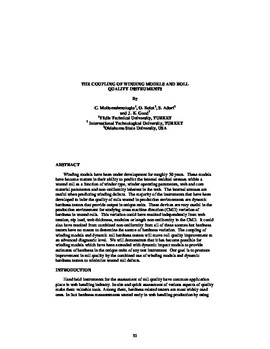| dc.contributor.author | Mollamahmutoglu, C. | |
| dc.contributor.author | Bulut, O. | |
| dc.contributor.author | Adari, S. | |
| dc.contributor.author | Good, J. K. | |
| dc.contributor.other | International Conference on Web Handling (2015) | |
| dc.date.accessioned | 2019-11-12T17:30:10Z | |
| dc.date.available | 2019-11-12T17:30:10Z | |
| dc.date.issued | 2015-06 | |
| dc.identifier | oksd_icwh_2015_mollamahmutoglu1 | |
| dc.identifier.citation | Mollamahmutoglu, C., Bulut, O., Adari, S., & Good, J. K. (2015, June). The coupling of winding models and roll quality instruments. Paper presented at the Thirteenth International Conference on Web Handling (IWEB), Stillwater, OK. | |
| dc.identifier.uri | https://hdl.handle.net/11244/322034 | |
| dc.description.abstract | Winding models have been under development for roughly 50 years. These models have become mature in their ability to predict the internal residual stresses within a wound roll as a function of winder type, winder operating parameters, web and core material parameters and non-uniformity inherent in the web. The internal stresses are useful when predicting winding defects. The majority of the instruments that have been developed to infer the quality of rolls wound in production environments are dynamic hardness testers that provide output in unique units. These devices are very useful in the production environment for studying cross machine direction (CMD) variation of hardness in wound rolls. This variation could have resulted independently from web tension, nip load, web thickness, modulus or length non-uniformity in the CMD. It could also have resulted from combined non-uniformity from all of these sources but hardness testers have no means to determine the source of hardness variation. The coupling of winding models and dynamic roll hardness testers will move roll quality improvement to an advanced diagnostic level. We will demonstrate that it has become possible for winding models which have been extended with dynamic impact models to provide estimates of hardness in the unique units of any test instrument. Our goal is to promote improvement in roll quality by the combined use of winding models and dynamic hardness testers to minimize wound roll defects. | |
| dc.format | application/pdf | |
| dc.language | en_US | |
| dc.publisher | Oklahoma State University | |
| dc.rights | In the Oklahoma State University Library's institutional repository this paper is made available through the open access principles and the terms of agreement/consent between the author(s) and the publisher. The permission policy on the use, reproduction or distribution of the article falls under fair use for educational, scholarship, and research purposes. Contact Digital Resources and Discovery Services at lib-dls@okstate.edu or 405-744-9161 for further information. | |
| dc.title | Coupling of winding models and roll quality instruments | |
| osu.filename | oksd_icwh_2015_mollamahmutoglu1.pdf | |
| dc.description.department | Mechanical and Aerospace Engineering | |
| dc.type.genre | Conference proceedings | |
| dc.type.material | Text | |
